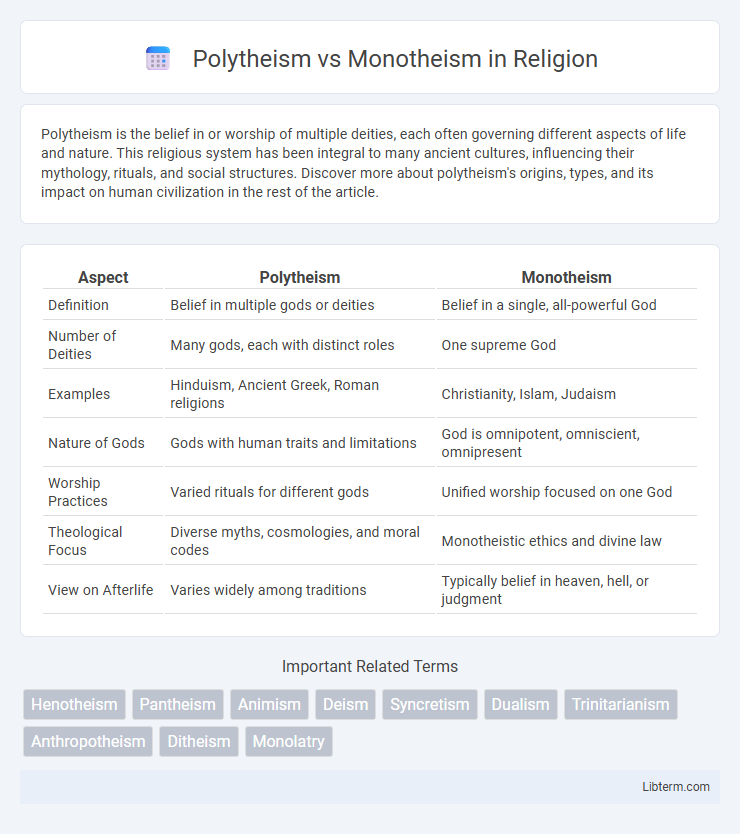Polytheism is the belief in or worship of multiple deities, each often governing different aspects of life and nature. This religious system has been integral to many ancient cultures, influencing their mythology, rituals, and social structures. Discover more about polytheism's origins, types, and its impact on human civilization in the rest of the article.
Table of Comparison
| Aspect | Polytheism | Monotheism |
|---|---|---|
| Definition | Belief in multiple gods or deities | Belief in a single, all-powerful God |
| Number of Deities | Many gods, each with distinct roles | One supreme God |
| Examples | Hinduism, Ancient Greek, Roman religions | Christianity, Islam, Judaism |
| Nature of Gods | Gods with human traits and limitations | God is omnipotent, omniscient, omnipresent |
| Worship Practices | Varied rituals for different gods | Unified worship focused on one God |
| Theological Focus | Diverse myths, cosmologies, and moral codes | Monotheistic ethics and divine law |
| View on Afterlife | Varies widely among traditions | Typically belief in heaven, hell, or judgment |
Understanding Polytheism and Monotheism
Polytheism involves the belief in multiple deities, each representing different aspects of life, nature, or human experience, whereas monotheism centers on the worship of a single, all-encompassing deity. Understanding polytheism requires recognizing the cultural, historical, and spiritual diversity reflected in various gods and goddesses, while monotheism emphasizes the concept of one supreme being who governs the universe. These belief systems shape distinct worldviews, rituals, and moral frameworks within their respective religious traditions.
Historical Origins and Development
Polytheism, characterized by the worship of multiple deities, originated in ancient Mesopotamia, Egypt, and the Indus Valley around 3000 BCE, reflecting early societies' attempts to explain natural phenomena and social order. Monotheism emerged significantly later, with Zoroastrianism around the 6th century BCE introducing a single supreme deity, and Judaism solidifying monotheistic beliefs through its covenantal traditions. The development of monotheism profoundly influenced religious, cultural, and political structures, leading to the rise of Christianity and Islam, which further shaped global religious landscapes.
Key Beliefs and Deities
Polytheism involves the belief in multiple deities, each governing different aspects of life, nature, or human experience, such as Greek gods Zeus and Athena or Hindu gods Vishnu and Shiva. Monotheism centers on the belief in a single, omnipotent, and omniscient deity, exemplified by religions like Christianity's God, Islam's Allah, and Judaism's Yahweh. Key beliefs in polytheism often include ritual worship of various gods and acceptance of multiple divine powers, while monotheism emphasizes exclusive devotion to one God, divine unity, and often the concept of an all-encompassing creator.
Rituals and Worship Practices
Polytheism involves diverse rituals honoring multiple deities, often including offerings, festivals, and elaborate ceremonies tailored to each god's attributes. Monotheism centers rituals on worshiping a single deity through prayer, sacraments, and communal gatherings, emphasizing devotion and obedience. Rituals in monotheistic traditions often seek direct connection with the singular divine, while polytheistic practices celebrate a pantheon reflecting natural forces and human experiences.
Social and Cultural Impact
Polytheism fosters diverse social structures through the veneration of multiple deities, often resulting in rich mythologies, rituals, and festivals that strengthen communal bonds and cultural identity. Monotheism typically promotes social cohesion by uniting followers under a single divine authority, shaping laws, moral codes, and centralized religious institutions that influence governance and societal norms. Both belief systems deeply impact art, literature, and education, reflecting their respective theological frameworks and shaping cultural heritage across civilizations.
Moral and Ethical Frameworks
Polytheism often promotes diverse moral and ethical frameworks reflecting the values and narratives of multiple deities, allowing for flexibility and pluralism in human behavior and societal norms. Monotheism typically establishes a unified moral code grounded in the commandments or teachings of a single, omniscient deity, emphasizing absolute ethical standards and accountability. These differing structures influence cultural attitudes towards justice, virtue, and human responsibility, shaping law, community cohesion, and individual conduct.
Influence on Art and Literature
Polytheism, with its rich pantheon of gods and mythological narratives, has inspired diverse artistic expressions and epic literature characterized by symbolic imagery, elaborate rituals, and multiple divine personas. Monotheism, centered on a singular deity, often emphasizes themes of unity, morality, and divine authority in art and literature, leading to iconic religious motifs, sacred texts like the Bible and Quran, and spiritual poetry. The distinct theological frameworks of polytheism and monotheism shape cultural creativity, influencing iconography, storytelling traditions, and the portrayal of supernatural elements across civilizations.
Conversion and Religious Conflicts
Conversion between polytheism and monotheism often triggered significant religious conflicts throughout history, as dominant monotheistic religions like Christianity and Islam sought to replace indigenous polytheistic beliefs. Missionary efforts and imperial expansions fueled tensions and sometimes violent confrontations, evident in events such as the Christianization of Europe and Islamic conquests. These conflicts shaped cultural identities and social structures, leading to the suppression or adaptation of polytheistic practices under monotheistic dominance.
Modern Perspectives and Trends
Modern perspectives on polytheism emphasize its resurgence in neo-pagan and indigenous spiritual movements, highlighting a shift towards pluralistic and nature-centered beliefs. Conversely, monotheism continues to dominate global religious demographics, with evolving interpretations that integrate science and social justice principles. Increasing intercultural dialogue fosters greater understanding and hybridization between these belief systems, reflecting broader trends in religious pluralism and individualized spirituality.
Interfaith Dialogue and Future Outlook
Interfaith dialogue between polytheistic and monotheistic traditions fosters mutual understanding by emphasizing shared values such as compassion, justice, and spiritual growth. These conversations promote coexistence and respect, reducing religious conflicts through highlighting common ethical frameworks and diverse theological perspectives. The future outlook for interfaith engagement envisions increased collaboration on social and environmental issues, leveraging the strengths of both polytheistic diversity and monotheistic unity to address global challenges.
Polytheism Infographic

 libterm.com
libterm.com